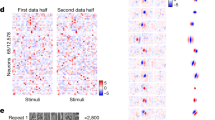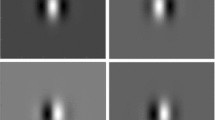Abstract
We present a reduction of a large-scale network model of visual cortex developed by McLaughlin, Shapley, Shelley, and Wielaard. The reduction is from many integrate-and-fire neurons to a spatially coarse-grained system for firing rates of neuronal subpopulations. It accounts explicitly for spatially varying architecture, ordered cortical maps (such as orientation preference) that vary regularly across the cortical layer, and disordered cortical maps (such as spatial phase preference or stochastic input conductances) that may vary widely from cortical neuron to cortical neuron. The result of the reduction is a set of nonlinear spatiotemporal integral equations for “phase-averaged” firing rates of neuronal subpopulations across the model cortex, derived asymptotically from the full model without the addition of any extra phenomological constants. This reduced system is used to study the response of the model to drifting grating stimuli—where it is shown to be useful for numerical investigations that reproduce, at far less computational cost, the salient features of the point-neuron network and for analytical investigations that unveil cortical mechanisms behind the responses observed in the simulations of the large-scale computational model. For example, the reduced equations clearly show (1) phase averaging as the source of the time-invariance of cortico-cortical conductances, (2) the mechanisms in the model for higher firing rates and better orientation selectivity of simple cells which are near pinwheel centers, (3) the effects of the length-scales of cortico-cortical coupling, and (4) the role of noise in improving the contrast invariance of orientation selectivity.
Similar content being viewed by others
References
Anderson J, Carandini M, Ferster D (2000) Orientation tuning of input conductance, excitation, and inhibition in cat primary visual cortex. J. Neurophysiol. 84: 909–926.
Anderson J, Lampl I, Gillespie D, Ferster D (2000) The contribution of noise to contrast invariance of orientation tuning in cat visual cortex. Science 290: 1968–1972.
Azouz R, Gray CM, Nowak LG, McCormick DA (1997) Physiological properties of inhibitory interneurons in cat striate cortex. Cereb. Cortex 7: 534–545.
Benardete E, Kaplan E (1999) The dynamics of primate M retinal ganglion cells. Visual Neurosci. 16: 355–368.
Ben-Yishai R, Bar-Or R, Sompolinsky H (1995) Theory of orientation tuning in the visual cortex. Proc. Nat. Acad. Sci. USA 92: 3844–3848.
Blasdel G (1992) Differential imaging of ocular dominance and orientation selectivity inmonkey striate cortex. J. Neurosci. 12: 3115–3138.
Bonhoeffer T, Grinvald A (1991) Iso-orientation domains in cat visual cortex are arranged in pinwheel like patterns. Nature 353: 429–431.
Borg-Graham L, Monier C, Fregnac Y (1998) Visual input evokes transient and strong shunting inhibition in visual cortical neurons. Nature 393: 369–373.
Bressloff P, Coombes S (2000) Dynamics of strongly coupled spiking neurons. Neural Comput. 12: 91–129.
Callaway E (1998) Local circuits in primary visual cortex of the macaque monkey. Ann. Rev. Neurosci. 21: 47–74.
Callaway E, Wiser A (1996) Contributions of individual layer 2 to 5 spiny neurons to local circuits in macaque primary visual cortex. Visual Neurosci. 13: 907–922.
Chance F, Nelson S, Abbott LF (1999) Complex cells as cortically amplified simple cells. Nature Neurosci. 2: 277–282.
Das A, Gilbert C (1999) Topography of contextual modulations mediated by short-range interactions in primary visual cortex. Nature 399: 655–661.
DeAngelis G, Ghose R, Ohzawa I, Freeman R (1999) Functional micro-organization of primary visual cortex: Receptive field analysis of nearby neurons. J. Neurosci. 19: 4046–4064.
De Valois R, Albrecht D, Thorell L (1982) Spatial frequency selectivity of cells in macaque visual cortex. Vision Res. 22: 545–559.
Ermentrout GB (1994) Reduction of conductance based models with slow synapses to neural networks. Neural Comput. 6: 679–695.
Feller W (1968) An Introduction to Probability Theory and Its Applications. John Wiley, New York.
Ferster D, Chung S, Wheat H (1996) Orientation selectivity of thalamic input to simple cells of cat visual cortex. Nature 380: 249–252.
Fitzpatrick D, Lund J, Blasdel G (1985) Intrinsic connections of macaque striate cortexAfferent and efferent connections of lamina 4C. J. Neurosci. 5: 3329–3349.
Gerstner W (1995) Time structure of the activity in neural network models. Phys. Rev. E 51: 738–758.
Gibson J, Beierlein M, Connors B (1999) Two networks of electrically coupled inhibitory neurons in neocortex. Nature 402: 75–79.
Hansel D, Sompolinsky H (1998) Modeling Feature Selectivity in Local Cortical Circuits. MIT Press, Boston, MA. pp. 499–567.
Hirsch J, Alonso JM, Reid R, Martinez L (1998) Synaptic integration in striate cortical simple cells. J. Neurosci. 15: 9517–9528.
Jagadeesh B, Wheat H, Kontsevich L, Tyler C, Ferster D (1997) Direction selectivity of synaptic potentials in simple cells of the cat visual cortex. J. Neurophysiol. 78: 2772–2789.
Knight B, Manin D, Sirovich L (1996) Dynamical models of interacting neuron populations. In: Gerf E, ed. Symposium on Robotics and Cybernetics: Computational Engineering in Systems Applications. Cite Scientifique, Lille, France.
Laing C, Chow C (2001) Stationary bumps in networks of spiking neurons. Neural Comput. 13: 1473–1494.
Lund JS (1987) Local circuit neurons of macaque monkey striate cortex: Neurons of laminae 4C and 5A. J. Comp. Neurology 257: 60–92.
Maldonado P, Godecke I, Gray C, Bonhoeffer T (1997) Orientation selectivity in pinwheel centers in cat striate cortex. Science 276: 1551–1555.
McLaughlin D, Kovacic G (2001) Private communication.
McLaughlin D, Shapley R, Shelley M, Wielaard J (2000) A neuronal network model of macaque primary visual cortex (V1): Orientation selectivity and dynamics in the input layer 4Cα. Proc. Natl. Acad. Sci. USA 97: 8087–8092.
Nykamp D, Tranchina D (2000) A population density method that facilitates large-scale modeling of neural networks: Analysis and application to orientation tuning. J. Comput. Neurosci. 8: 19–50.
Nykamp D, Tranchina D (2001) A population density method that facilitates large-scale modeling of neural networks: Extension to slow inhibitory synapses. Neural Comput. 13: 511–546.
Palmer L, Davis T (1981) Receptive-field structure in cat striate cortex. J. Neurophysiol. 46: 260–276.
Pugh M, Ringach D, Shapley R, Shelley M (2000) Computational modeling of orientation tuning dynamics in V1 neurons. J. Comp. Neurosci. 8: 143–159.
Reid RC, Alonso JM (1995) Specificity of monosynaptic connections from thalamus to visual cortex. Nature 378: 281–284.
Ringach D, Hawken M, Shapley R (1997) Dynamics of orientation tuning in macaque primary visual cortex. Nature 387: 281–284.
Ringach D, Shapley R, Hawken M (2001) Diversity and laminar dependence of orientation selectivity in simple and complex cells of macaque v1. J. Neurosci. 21(14).
Sclar G, Freeman R (1982) Orientation selectivity in the cat's striate cortex is invariant with stimulus contrast. Exp. Brain Res. 46: 457–461.
Shapley R, Reid C (1998) Private communication.
Shelley M, McLaughlin D, Cai D (2001) Point neuron and mean firing rate models of primary visual cortex.
Shelley M, McLaughlin D, Shapley R, Wielaard J (2001) The high conductance state caused by visual stimulation in a large-scale computational model of the visual cortex: An emergent separation of time scales.
Somers D, Nelson S, Sur M (1995) An emergent model of orientation selectivity in cat visual cortical simple cells. J. Neurosci. 15: 5448–5465.
Sompolinsky H, Shapley R (1997) New perspectives on the mechanisms for orientation selectivity. Current Opinion in Neurobiol. 7: 514–522.
Tolhurst D, Dean A (1990) The effects of contrast on the linearity of spatial summation of simple cells in the cat's striate cortex. Exp. Brain Res. 79: 582–588.
Treves A (1993) Mean field analysis of neuronal spike dynamics. Network 4: 259–284.
Troyer T, Krukowski A, Priebe N, Miller K (1998) Contrast invariant orientation tuning in cat visual cortex with feedforward tuning and correlation based intracortical connectivity. J. Neurosci. 18: 5908–5927.
Wielaard J, Shelley M, Shapley R, McLaughlin D (2001) Howsimple cells are made in a nonlinear network model of the visual cortex. J. Neurosci. 21(14): 5203–5211.
Wilson H, Cowan J (1973) A mathematical theory of the functional dynamics of cortical and thalamic nervous tissue. Kybernetik 13: 55–80.
Author information
Authors and Affiliations
Rights and permissions
About this article
Cite this article
Shelley, M., McLaughlin, D. Coarse-Grained Reduction and Analysis of a Network Model of Cortical Response: I. Drifting Grating Stimuli. J Comput Neurosci 12, 97–122 (2002). https://doi.org/10.1023/A:1015760707294
Issue Date:
DOI: https://doi.org/10.1023/A:1015760707294




